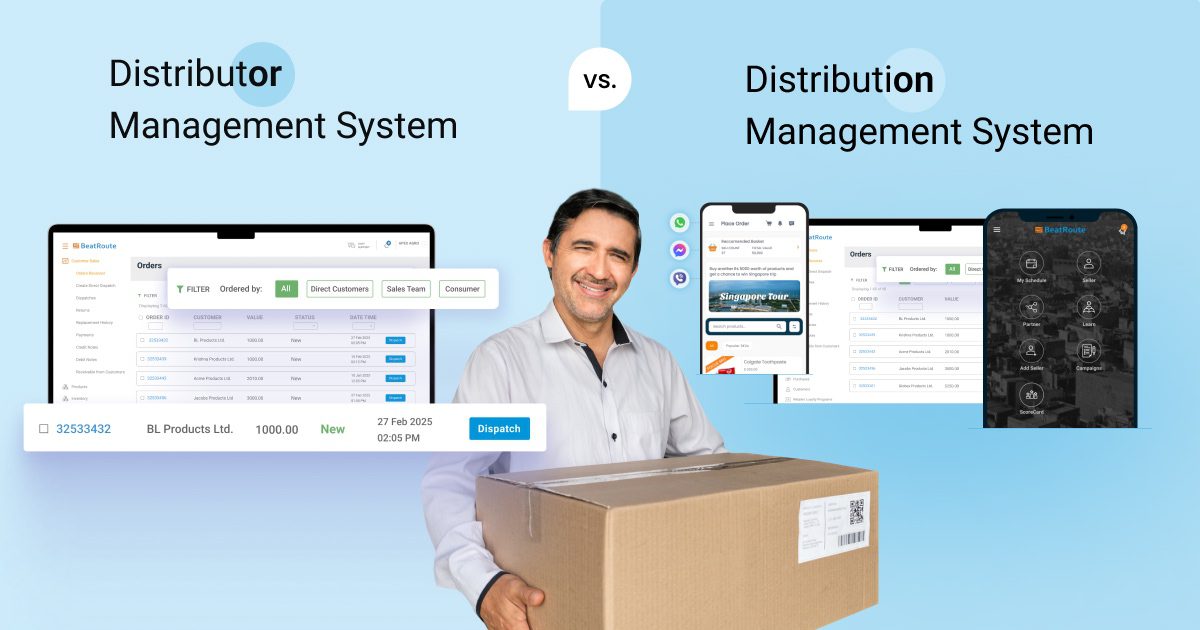Distributor Management System vs. Distribution Management System: Which One Fits Your Brand’s Needs

The retail distribution world has changed a lot in recent years. Customer demands are higher, supply chains are more complex, and competition is fiercer than ever.
With such a volatile market, retail brands that still rely on legacy systems and traditional methods to manage all these moving parts may find themselves outpaced by more agile competitors.
In fact, research shows that 60% of businesses say legacy systems are holding them back from responding quickly to market changes, while 40% report errors due to manual processes.
As a CEO or CIO, staying ahead of the game means constantly finding ways to improve margins, reduce friction, and scale efficiently. But with so many moving parts and systems to choose from, it’s easy to feel stuck. A lot of retail brands get confused when deciding between a Distributor Management System and a Distribution Management System. While both promise to improve operations, their use cases vary, leaving many unsure of which one is the best fit.
In this blog, we’ll clear up that confusion and guide you to the right choice for your retail brand. We’ll walk you through the differences between the two systems and show you how each one can help improve your operations and put you on the path to sustainable growth.
What is a Distributor Management System
A Distributor Management System is a tool that helps retail brands better manage and optimise their relationships with distributors. It handles key tasks like processing orders, tracking sales, and managing payments, allowing brands to operate more smoothly, save on costs, and make smarter, data-driven decisions.
For example, instead of manually tracking payments and credit through emails or Excel sheets, a Distributor Management System automatically generates invoices and keeps track of what’s been paid or is still due. This real-time visibility helps brands stay on top of their finances and build stronger, more transparent relationships with their distributors.
Key Features of a Distributor Management System
- Order Processing:
Automating the order process ensures faster and more accurate fulfilment, reducing errors and avoiding stock outs. It streamlines updates to stock levels and order management, ensuring products are delivered on time. - Sales Tracking:
Real-time sales tracking helps distributors monitor product performance and quickly adjust strategies, such as shifting inventory or modifying schemes, to maximise sales opportunities. - Invoicing & Credit Management:
Automation of invoicing and credit management reduces errors and speeds up processing, improving cash flow and financial oversight for smoother operations. - Claim Management:
Simplified claim processes allow distributors to quickly submit and track claims, resolving issues like damaged goods or order discrepancies faster and improving relationships with retailers. - Distributor Performance Tracking:
Tracking distributor performance, especially in General Trade (GT) and Modern Trade (MT) channels, ensures that delivery times, order accuracy, and sales targets are met, enabling brands to optimise their strategies and resources.

Challenges in Existing Distributor Management Systems
Many distributors still rely on separate tools for different tasks, which creates fragmented data and inefficiencies. For example, tracking inventory in one system and sales in another can cause errors and make reporting more complicated. Without a way to connect everything, it becomes hard to get accurate, real-time data, making it tough to react quickly to changes in customer demand or market shifts. These old systems can’t keep up with the fast pace of today’s retail distribution ecosystem, leading to several key challenges including:
- Lack of Integration: Distributors often use disconnected tools like spreadsheets, tally, or outdated accounting software, causing inefficiencies and data silos. Without integration, critical information doesn’t flow smoothly between systems, creating delays and errors.
- Manual Processes: Small distributors in remote areas may still rely on pen-and-paper methods for stock management, and orders are often communicated via WhatsApp, email, or phone calls. This fragmented approach leads to delays, errors, and a lack of visibility into real-time operations.
- Limited Visibility into Secondary Sales: Without an integrated system, tracking sales beyond the first transaction becomes nearly impossible. Retail brands are often left in the dark about secondary sales, making it difficult to measure overall performance or adapt strategies.
- Promotion Management Issues: Managing promotions manually is not only time-consuming but also prone to errors. Without a centralised system, measuring the effectiveness of promotions can be difficult, leading to missed opportunities or confusion across teams.
- Inconsistent Financial Tracking: Using manual tools for invoicing and credit management leads to inconsistencies, errors, and poor financial oversight, making it harder to maintain a healthy cash flow and manage payments efficiently.

Benefits of Using a Distributor Management System
Disjointed tools and fragmented data lead to delays, errors, and inefficiencies that disrupt distribution networks. A Distributor Management System helps overcome these challenges by unifying and automating processes, enabling distributors and retail brands to operate more efficiently.
Listed below are some of the common benefits of implementing a Distributor Management System:
- Integration and Automation
A Distributor Management System connects order handling, sales tracking, inventory management, and invoicing into one cohesive platform. This integration eliminates the need for multiple tools, reducing human error and streamlining processes.
For example, distributors can receive new orders, check stock levels, and process invoices all in one system, with real-time updates, ensuring timely deliveries and minimising stockouts. - Real-Time Visibility
A Distributor Management System provides immediate access to crucial data, such as stock levels, sales performance, and order status. This enables quicker decision-making and proactive responses to changes, like adjusting stock count in response to demand spikes or shifting products between regions based on sales trends. - Seamless Scheme Management
Managing promotions or schemes can be complex, especially when tracking effectiveness in real-time. A Distributor Management System simplifies this by consolidating all promotional data in one place, making it easier to evaluate ROI and adjust strategies quickly.
For example, a brand running a promotional campaign for a new product in different regions can use a Distributor Management System to track the success of each region’s campaign in real-time. If sales in one region are performing better than others, the system allows the brand to quickly reallocate resources—like adjusting stock levels, increasing marketing spend, or offering additional incentives in underperforming areas. - Accurate Financial Management
Automated invoicing and credit management tools improve cash flow, reduce errors, and enhance financial control.
For example, instead of manually creating invoices and tracking payments through spreadsheets or emails, a Distributor Management System automates the entire invoicing process.
Distributors can ensure that every transaction is recorded accurately and payments are processed on time, reducing the chances of errors or delays. This streamlines financial oversight, reducing payment dilemmas and improving the relationship between the brand and its distributors by ensuring timely and accurate financial transactions. - Stronger Distributor Relationships
Transparent and efficient operations foster trust and collaboration between brands and distributors. A Distributor Management System provides clear data and insights into every part of the distribution process, helping both parties align on objectives, improve communication, and ensure long-term, mutually beneficial relationships.

What is a Distribution Management System
A Distributor Management System and a Distribution Management System both help retail brands streamline distribution, but they serve different functions. Although they are often perceived as one and used interchangeably, a Distributor Management System is actually a subset of the Distribution Management System. Think of it like the engine (Distributor Management System) and the car (Distribution Management System).
While the Distributor Management System focuses on managing relationships with distributors by automating tasks like order processing, tracking sales, and invoicing, the Distribution Management System manages the entire distribution network. It connects manufacturers, distributors, and retailers in real-time, providing end-to-end visibility and control over the entire distribution process, from the warehouse to the retailer’s shelf. This includes optimising routes for field sales teams and tracking inventory, orders, and deliveries in real-time—helping brands reduce inefficiencies, optimise their supply chain, and improve customer satisfaction.
Key Features of a Distribution Management System
- Supply Chain Integration
Connects the entire supply chain from warehouse to retailer, providing real-time data and visibility.
For example, it ensures that companies can track product movement at every stage, improving speed and efficiency. - Sales Force Automation
Enables the sales team to access real-time data from distributors and retailers, helping them make informed decisions.
Sales reps can track stock levels and adjust their sales approach accordingly, maximising opportunities. - Stakeholder Collaboration
Facilitates seamless communication between manufacturers, distributors, and retailers.
This ensures all parties are aligned on orders, inventory, and schemes, improving coordination. - Visit Planning & Route Optimisation
AI-driven tools that optimise field sales visits, reducing travel time and increasing sales productivity.
The system helps sales teams plan the most efficient routes, allowing for more time with customers. - Sales Analytics
Tracks performance across the distribution network, offering insights into sales trends and bottlenecks.
It helps identify underperforming areas, so brands can adjust inventory or schemes to improve sales.

Challenges in Existing Distribution Management Systems
Many brands still rely on legacy systems to manage their distribution, and while these outdated methods have been in place for years, they often create more problems than they solve. Companies are often reluctant to embrace innovation, mainly due to the lack of knowledge on how to implement new technologies effectively. This resistance leads to inefficiencies, confusion, and missed opportunities, especially when managing multiple stakeholders and complex supply chains. Without an integrated system, it becomes nearly impossible to maintain a real-time, holistic view of the supply chain, leading to slower decision-making and frustration across the distribution network.
Here are some of the common challenges faced by businesses:
- Complex Stakeholder Coordination: Misalignment between manufacturers, distributors, and retailers often leads to inefficiencies and confusion. Without a unified platform, it becomes difficult for all parties to stay aligned on stock levels, orders, and promotional strategies.
- Supply Chain Visibility Gaps: Traditional systems may not provide a real-time, holistic view of the entire supply chain. This results in delayed decision-making and missed opportunities, as businesses struggle to track inventory, monitor order statuses, and respond to changing customer demands.
- Managing Distribution Channels: Companies often struggle with managing different channels effectively, which can lead to missed opportunities and inefficiencies. For example, a brand may find it difficult to manage its General Trade (GT) and Modern Trade (MT) channels, where the needs of independent retailers and large supermarkets vary. This can result in poor resource allocation and missed sales opportunities.
- Reluctance to Embrace AI Technology: Many companies hesitate to integrate AI into their distribution processes, missing out on the potential benefits of AI-driven tools for route optimisation, sales forecasting, and predictive analytics. This reluctance keeps them from harnessing the power of real-time insights to improve operational efficiency.
- Lack of Real-Time Data Access: Without an integrated system, distributors and sales teams lack access to real-time data, which can lead to slow responses to market shifts and customer demands. Without up-to-date information on stock levels, sales performance, and order statuses, brands can miss critical opportunities.

Benefits of Using a Distribution Management System
A Distribution Management System offers several key benefits for retail brands looking to optimise their distribution processes. It centralises data and automates tasks, enhancing efficiency across the distribution network. By connecting distributors, retailers, and stakeholders in real-time, it provides better visibility, reduces errors, and enables faster, more informed decision-making.
Here are some of the many benefits of implementing a Distribution Management System into your retail execution strategy:
- Real-Time Communication and Data Sharing
A unified platform connects your sales force, distributors, and retailers, enabling instant updates on stock, sales performance, and promotions. This ensures everyone stays aligned, speeding up decision-making and improving coordination. - Order Management
Real-time tracking of orders, stock levels, and deliveries ensures timely replenishment and reduces stockouts.
In industries like Building Materials, where managing large product inventories can be challenging, this system ensures timely product availability at construction sites and retail outlets. - Schemes and Offers
Easily track and manage promotions across your network to ensure accurate execution and optimal resource allocation. In the HORECA channel, this helps distributors monitor and deliver schemes and offers for restaurants and cafés efficiently. - Enhanced Collaboration
The system improves communication between manufacturers, distributors, and retailers, reducing errors and inefficiencies. This is particularly valuable in the FMCG industry, where alignment on inventory management and promotional campaigns is crucial for success. - AI Optimised Field Operations
AI-powered visit planning and route optimisation help sales teams minimise travel time and boost productivity. In industries like FMCG, where large sales forces cover vast territories, AI ensures reps are strategically allocated to the right locations, optimising their time and reducing costs.
Route optimisation further streamlines travel, enabling more efficient coverage and higher sales performance. A survey reveals that 41% of industry experts view AI in distribution as a game-changer for 2025. - Improved Sales Performance
Real-time insights help identify performance gaps and adjust strategies quickly. Brands can fine-tune their sales approach based on data, ensuring growth and alignment with targets. - Configurable and Scalable Platform
The system is highly customisable, allowing you to adjust KPIs, workflows, and reporting metrics to meet your evolving business needs.Whether expanding into new regions or adding product lines, the system scales effortlessly.

Distributor Management System vs. Distribution Management System: A Quick Comparison Guide
Check out this side-by-side comparison to easily differentiate between both Distributor Management System vs. Distribution Management System:
| Distributor Management System | Distribution Management System |
| Focuses on managing relationships with individual distributors. | Manages the entire distribution network, from warehouse to retailer. |
| Automates tasks like order processing, sales tracking, and invoicing. | Provides end-to-end visibility, managing orders, inventory, and delivery across the entire supply chain. |
| Primarily used for improving communication and coordination with distributors. | Focuses on optimising the whole distribution process, including routing and sales performance. |
| Best suited for brands looking to streamline distributor-related operations. For example, FMCG brands like Unilever or Procter & Gamble rely on Distributor Management Systems to manage relationships with their distributors and track orders efficiently. | Ideal for brands that need real-time visibility and control over their entire distribution ecosystem. For example, Amazon uses a Distribution Management System to oversee its entire supply chain and logistics network, ensuring that stock levels and deliveries are tracked in real-time across multiple regions. |
| Tracks sales and performance data at the distributor level to adjust strategies. | Tracks sales across all regions and channels, adjusting strategies in real-time based on full supply chain data. |
| Less integration with external systems, primarily focused on distributor-specific functions. | Highly integrated, connecting all parts of the supply chain, including manufacturers, distributors, and retailers. |
| Often more suitable for smaller to medium-sized brands with specific distributor networks. | Best for large-scale brands with complex distribution networks across multiple regions and channels. |

Have You Found the System That Fits Your Needs?
We hope this blog helps you decide between a Distributor Management System and a Distribution Management System. If you’re still unsure, here are some quick pointers to guide you:
- Evaluate Your Organisation’s Strengths
If you aim to streamline distributor operations, the Distributor Management System is the right choice. - Assess Your Distribution Network
If you’re looking for visibility across your entire network, a Distribution Management System will give you the control you need. - Consider Your Growth Ambitions
For quick scaling, a Distributor Management System works well. But for long-term growth and sustainability, go with a Distribution Management System. - Technology Readiness
If you’re ready to embrace AI-driven tools for route optimisation and demand forecasting, a Distribution Management System is ideal. If not, start with a Distributor Management System.
As you weigh your options, BeatRoute’s platform stands out with its Goal-Driven Sales Tech (GDST) capabilities. Unlike other solutions, BeatRoute is designed to align every decision and action with your business goals, ensuring measurable results.
Brands leveraging our platform have already seen measurable growth—12.6% sales uplift through GDST for sales teams, 5.2% sales uplift for customers, and 16% cost savings through improved efficiency in route-to-market execution.
Book a demo today to explore how BeatRoute can replicate this sales impact and help your retail business elevate.
About the Author
-
Surya Panicker is the Head of Content at BeatRoute, where she leads content strategy for India’s goal-driven sales platform. With 9 years in marketing automation and SaaS, Surya specializes in building content that translates complex solutions into actionable business outcomes. Her approach combines data-driven insights with a storytelling mindset, always putting the customer at the center of her narratives. Surya focuses on aligning brand messaging with audience needs to deliver practical results. Outside of work, she enjoys exploring new cuisines, reading fiction, and traveling with her family.
Use Goal-Driven AI to Achieve Retail Sales Uplift, Today!
Join enterprises in 20+ countries that trust BeatRoute, the globally dominant AI platform for sales force automation, field sales, DMS, and eB2B
Latest Insights & Articles
Here are the most impactful articles, platform updates, ebooks and reports for you.







 Whether expanding into new regions or adding product lines, the system scales effortlessly.
Whether expanding into new regions or adding product lines, the system scales effortlessly.


